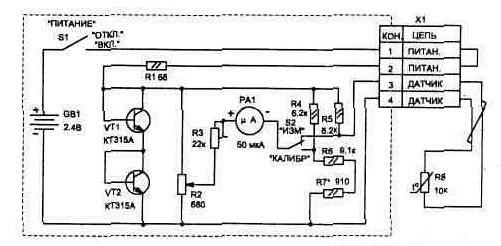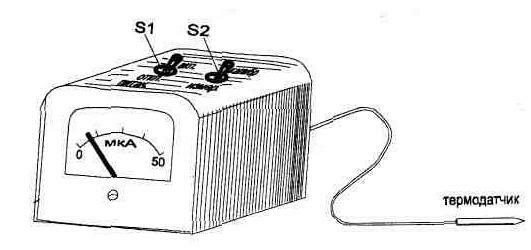Everyone had during the illness to measure yourself the temperature of the mercury thermometer. This procedure usually takes 5 to 7 minutes. If adults hold a thermometer safely, the children are forced to watch so they do not accidentally broke.
The proposed device allows you 3 seconds to measure the temperature of the body or an object (e.g. chips) in the range of 20 to 45°C with accuracy not worse than 0.1°C. This range if desired, can be expanded easily or slide in manufacturing.
Compared with mercury thermometer electric more convenient and safe, especially when you have to measure temperature in small children or animals.

Fig. 1.12. The electrical circuit of the thermometer
Based on the structure of the schema (Fig. 1.12) pavement taken Converter. The change in the resistance value of the temperature sensor leads to R8 the imbalance of the bridge and the appearance of a dial indicator PA1 current proportional to temperature.
A feature of this device is the use of as temperature sensor thermistor type STZ-19 10 kOhm, which has very small mass, whereby it is possible to obtain high measurement speed. This sensor is conveniently mounted on the end of a plastic tube from a ballpoint pen and intertwined between a wire of length 1...0.6 m connector X1 to connect to the measuring unit. On the connector from the sensor between pins 1 and 2 installed. the jumper, which will not allow you to include a diagram of the device, if not connected the temperature sensor that protects the measuring device from RA1 damage. Eats scheme from any two batteries or batteries with a total voltage of 2...and 3 In consumes from the source current 5 mA.
Transistors VT1 and VT2 are used as low-voltage the Zener can be replaced with CTA, B, C, G.
Variable resistors, for ease of configuration, better apply multi-turn, type SP5-2 or similar.
Dimensions of the device are determined by the size of the arrow indicator PA1, and when using a microammeter M on current 0...50 µa they do not exceed HH mm (see Fig. 1.13).
The PCB layout and placement of elements it is shown in Fig. 1.14.
Instrument setup start with measuring the resistance resistor R8 (preferably with high precision) at a fixed temperature 20°C. For these purposes, it is convenient to use industrial heat chamber with automatic maintenance of the set temperature, where the temperature sensor is placed. There are other possible the means of obtaining the temperature of 20°C but should note that the accuracy of measurement of the resistance of the temperature sensor when this temperature depends on the accuracy of the measuring instrument.

Fig. 1.13. Appearance design

Fig. 1.14
After measuring R8 of the two resistors R6+R7 select the same nominal resistance and solder them into the scheme.
After that, setting the engines of resistors R2 and R3 in the middle position, turn on the circuit by switch S1 and performs a sequence of the following operations:
a) set the switch 82 in position CALIBRATION and resistor R2 to withdraw the arrow of a measuring instrument to zero on scale;
b) place the temperature sensor in a location where you know, a constant temperature (within the desired measuring range);
b) set switch S2 to position MEASUREMENT and the resistor R3 to set the arrow of the device on the scale value that will be be consistent with the measured value;
Operations a), b) and C) must be repeated consistently several times, after which the setting can be considered finished.
In conclusion, I would like to note that the customized the instrument measurement range can be shifted by the resistor R2 when switching in the CALIBRATION mode and setting the arrow (its position will correspond the value 20°C) for any value of the scale. After that, when switching device in the MEASUREMENT mode the scale will be accordingly shifted relative to cursor position in the CALIBRATION mode.
The device has a large supply sensitivity which increases with the decrease of the resistance R3 (during initial setup). You can make the device sensed temperature of breathing or a change temperature with air circulation.
Publication: www.cxem.net






